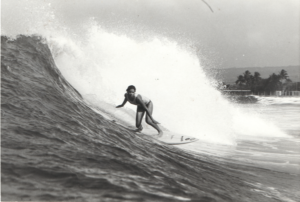Ever heard of a “talking heads” documentary that is funny, endearing, thrilling, witty, sad, life affirming, exciting and informative? No? Neither had I, until recently. Hang onto your boardshorts, surfboards, and sunscreen, because I’m going to let you in on a secret… involving one of the most uplifting and entertaining cinema experiences I have had in ages. It’s a film is called “Girls Can’t Surf.” I’ll give you a hint. If you haven’t already got it, (and lots of blokes may not have), the title is ironic. By the end of the film’s 108 minutes you will be convinced, (if you watch, listen, and think about the content), that girls can surf despite the attempts of many within the surfing industry, many male professional surfers, and a large proportion of the management of professional surfing back in the early days of pro surfing, to convince women who were aspiring to careers in surfing that they couldn’t.

Never fear. It’s not all talking heads. In between present-day interviews of the film’s “stars” and archival interviews of the stars from the period that the movie covers (primarily 1970s, 1980s and 1990s) there are clips of early female professional surfers displaying their craft in beautiful waves, enormous waves, and horrendous, win-blown, tiny, unrideable waves. There are also archival snap shots of newspaper headlines, letters, crowd scenes, advertisements, and other historical documents. While the surfing action is enthralling, in truth, surprisingly, it is the commentary of the stars (the talking heads, themselves) of the film that give the movie it’s guts. The waves, the blokes, the surfboards, the beaches… and the bikini-clad beach models… are very much the supporting cast.
Punters booed the male surfers
While the central concern of the film is to track the emergence and evolution of women’s professional surfing and to highlight the discrimination, misinformation, harassment and poor pay and conditions the early professionals experienced it is the character and quality of the women involved that become the standout feature of the movie, for me. Has there ever been a more thoroughly likable group to emerge from the history of any professional sport? The intelligent, courageous, and articulate Jodie Cooper. The cheeky, funny, and forthright Smith twins (Jorja and Jolene). The delightful, quirky, self-deprecating, and brave Pauline Menczer. The prickly, smart-alecky, hilarious and totally lovable Wendy Botha. The excruciatingly honest, gritty, determined girl next door Pam Burridge. And then there is Lisa Anderson, Layne Beachley, Frieda Zamba, Rochelle Ballard and more. What a cast! These are the good guys (well, girls). The film also has its share of bad guys, too. Surprise, surprise. Most of them are blokes. The words of the likes of Nat Young, Damien Hardman, and Rob Bain, (legends of Australian surfing), ensure that they end up being the wearers of black hats and pencil-thin moustaches for the movie. Nat’s thoughtful evaluation, “the top (male) surfers from any beach could defeat any woman that I have ever seen… and that goes for Frieda or Jodie or any of them,” even managed to score him a round of boos from the punters at the screening I attended.
It is the stories from the lives of the women that will stick with me for a long time.
Jodie Cooper’s failure to win a world title is (though she thoroughly deserved one or two) one example. Her bad luck in her battles for the crown inspired her to suggest, (when asked how she could beat her main rival, Frieda Zamba), “with a big lump of wood!” Cooper also described the humiliation and feelings of lack of worth she experienced when she received the tip off that she was about to be dumped by her sponsor because of her sexual orientation.
Pauline Menczer might have won a world title, but it did little to alleviate the poverty she experienced throughout her life.
“I’d buy 25 pairs of Levi jeans. You’d pay 25 dollars for them in America and sell them for 150 in France,” said Menczer explaining how the unsponsored world champion managed to raise enough money to stay on the world tour.
Surf historian, Nick Carroll set out how it works.

“As a man you could get a sponsorship just by winning a few heats. But for a woman to get a good sponsorship you had to be good looking in a conventional sense, you had to smile for the cameras, and on top of that you had to win more than a few heats… like maybe World Champ or close to it!”
Unfortunately for Menczer, she didn’t meet the criteria that most of the surf companies were looking for. When, as a newly crowned world champion, she attended trade shows in the USA hoping to pick up a sponsorship that would help fund her travel costs while on tour she said she was offered a pair of sunglasses!
Pam Burridge’s battle to win a world championship and her efforts to promote and build women’s surfing as a viable professional sport nearly cost her her life!
“All you girls need to lose weight… then we could promote the sport. Is it a coincidence that two years later I was anorexic and on the verge of death?” said Burridge explaining how a message from a surf industry leader caused her to fall into a spiral of starvation and substance abuse.
Fortunately for Burridge, with the help of her partner, Mark Rabbidge, she managed to overcome her health issues and self-doubt and finally secured a World Championship crown in 1990. Her long-delayed success delighted the Australian sports loving public, the surfing community and fellow competitors including her main rival, the delightfully grumpy, Wendy Botha.
Botha said, “…anybody else and I would have been filthy again, but, you know, I was really happy (for Pam). I don’t know why… cos’ it’s not like me!”
“Shitty hell hole scum pit of the ocean is where they have the women”
Other than the frustrations of poverty (laughably low prize money), of not being good looking enough, of one’s sexual preference not being okay, the accusation of the women not being able to surf as well as the men probably infuriated the early female professional surfers more than anything else. How were the women supposed to demonstrate how well they could surf when they were relegated to perform (by contest organizers and contest sponsors) on pathetic waves that the men would never be expected to surf on?
Jamie Brisick, prominent surf journalist and author, explained in the film that when the waves were poor the men’s heats would be put on-hold and the women would be forced to go out and compete in surf that would make even the best surfers look bad. He added that the women’s heats being called would be the signal for thousands of spectators on the beach to go off to nearby restaurants to buy lunch.
“Well fuck… I’d leave the beach too if I had to watch the girls surfing in one foot, on-shore complete rubbish,” was Wendy Botha’s take on the situation.
Jolene Smith wasn’t happy about their treatment either!
“And this shitty hell hole scum pit of the ocean is where they have the women,” she said.

“Fuck,” added her twin sister Jorja!
It is remarkable that so many male surfers were convinced of the ineptitude of their surfing sisters when Jodie Cooper, Pauline Menczer, Pam Burridge, and Lisa Anderson had performed in Hawaiian big wave events with the same fearless abandon and steely competence that the best of the professional men had shown.
Whether you are a sports lover, a surf fanatic, a lover of great stories or someone who enjoys the unveiling of the characters and personalities of a remarkable bunch of individuals this movie is a must. The launch of “Girls Can’t Surf” is timely given the current political focus on women who are undervalued and mistreated and men who just don’t get it. Some sports documentaries leave you enthralled by the remarkable talent of the athletes. This film goes further. It not only convinces viewers of the extraordinary skill of the surfing world’s early women professionals, but it highlights what an endearing, lovable and downright decent bunch they were. Maybe if they had been bigger arseholes they might have been treated with appropriate respect earlier.
Flashy young demi-gods
And the men in the movie? Well, they have had their time in the limelight over the years and don’t win a lot of plaudits in this piece of cinema. I’ll leave it to surf journalist Nick Carroll to sum up how they look when viewed through the lens of the experience of their female colleagues.
They were “flashy young demi-gods with their neon surfboards and their highlighted hair and their impossible sense of their own magnificence,” explained Carroll!
If you feel like blowing raspberries at blokes behaving obnoxiously then this film could also be for you. Don’t miss it.
To the production team behind “Girls Can’t Surf”, Michaele Perske, Christopher Nelius and Julie Anne De Nuvo, great job and thanks!
To the men of pro surfing in the seventies and eighties… pffffffffft!


Leave a Reply